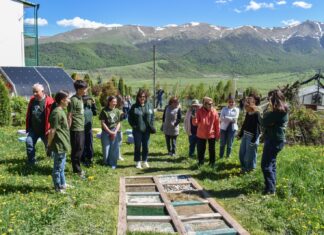POTSDAM, Germany — A revolutionary technology developed in Germany has made it possible to reconstruct an early version of Saint Gregory of Narek’s Book of Prayers (or Lamentations), conserved in the Matenadaran in Yerevan. The work is a manuscript dating back to the 13th-14th century, and is one of the earliest copies of the 10th century original, which has been lost. The task presented to restorers seemed hopeless due to the desperate condition of the manuscript. The book had fallen into decay, its pages reduced to fragments, and those were in utter disarray so that it was impossible to place the individual pieces of pages in their original order.
There was no way to salvage the precious manuscript using traditional methods of restoration. In 2016 the Fraunhofer Institute initiated a feasibility study to determine whether its methods could be successfully applied to recovering damaged documents at the Matenadaran. Fraunhofer is recognized as the leading organization for applied research in Europe, with 72 institutes and research centers (www.fraunhofer.de/en.html). The method adopted is known as automated virtual reconstruction; as explained in an article in the institute’s publication FUTUR, the so-called ePuzzler, which the Institute has developed, is “a reconstruction software that uses sophisticated image-processing and pattern detection algorithms to automatically recompose scanned paper fragments into complete pages.”
There are three stages in the reconstruction process. The fragments are digitized, to make it possible to process them virtually. “Then the ePuzzler processes the digital copies and reconstitutes them into full pages. The third stage goes beyond the reconstruction of single pages to embrace mechanisms both for the automated match-up of single pages to form complete files and for development of their content.”
Funded by the German Foreign Ministry, the Fraunhofer scientists organized two workshops in Yerevan, in which they presented the virtual reconstruction technology and preparation and procedure of digitalization work to the members of the staffs involved in restoration, digitalization, research and archive at the Matenadaran. Together they drew up potential applications scenarios, and selected and digitized exemplary material for sample processing. The results were very promising and work continued. At the end of last year, the Narek project was completed, with the financial support of the Foreign Ministry. The word was conducted by Fraunhofer collaborators Siranoush Varderesyan and Henry Zoberbier under the direction of Dr. Bertram Nickolay, head of the Department for Security Technology. It is expected that in September the results of the project will be presented to the public in Germany.
The advantages of the virtual reconstruction method pioneered by Fraunhofer should be obvious: in the case of ancient and damaged documents, it is important to reduce manual handling to an absolute minimum. Once the virtual reconstruction has been completed, work can proceed on actual physical restoration.
For the Matenadaran this technology may prove to be a godsend. The world famous institute in Yerevan houses a collection of inestimable value, parts of it have been welcomed into the “Memory of the World Register” of UNESCO. Its experts enjoy recognition internationally for their advanced skills in restoring books and documents and the institute, as FUTUR writes, “is the key reference point and port of call for all enquiries regarding restoration and reconstruction in the region.”[1] Despite this high level of expertise, work on restoring the immense amount of manuscripts has been hampered by the lack of adequate technical support.








